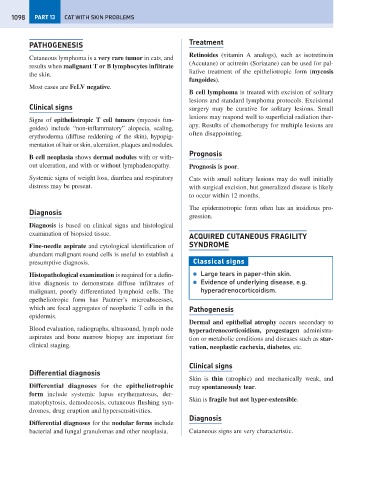Page 1106 - Problem-Based Feline Medicine
P. 1106
1098 PART 13 CAT WITH SKIN PROBLEMS
PATHOGENESIS Treatment
Retinoides (vitamin A analogs), such as isotretinoin
Cutaneous lymphoma is a very rare tumor in cats, and
(Accutane) or acitretin (Soriatane) can be used for pal-
results when malignant T or B lymphocytes infiltrate
liative treatment of the epitheliotropic form (mycosis
the skin.
fungoides).
Most cases are FeLV negative.
B cell lymphoma is treated with excision of solitary
lesions and standard lymphoma protocols. Excisional
Clinical signs surgery may be curative for solitary lesions. Small
lesions may respond well to superficial radiation ther-
Signs of epitheliotropic T cell tumors (mycosis fun-
apy. Results of chemotherapy for multiple lesions are
goides) include “non-inflammatory” alopecia, scaling,
often disappointing.
erythroderma (diffuse reddening of the skin), hypopig-
mentation of hair or skin, ulceration, plaques and nodules.
Prognosis
B cell neoplasia shows dermal nodules with or with-
out ulceration, and with or without lymphadenopathy. Prognosis is poor.
Systemic signs of weight loss, diarrhea and respiratory Cats with small solitary lesions may do well initially
distress may be present. with surgical excision, but generalized disease is likely
to occur within 12 months.
The epidermotropic form often has an insidious pro-
Diagnosis
gression.
Diagnosis is based on clinical signs and histological
examination of biopsied tissue.
ACQUIRED CUTANEOUS FRAGILITY
Fine-needle aspirate and cytological identification of SYNDROME
abundant malignant round cells is useful to establish a
presumptive diagnosis. Classical signs
Histopathological examination is required for a defin- ● Large tears in paper-thin skin.
itive diagnosis to demonstrate diffuse infiltrates of ● Evidence of underlying disease, e.g.
malignant, poorly differentiated lymphoid cells. The hyperadrenocorticoidism.
epetheliotropic form has Pautrier’s microabscesses,
which are focal aggregates of neoplastic T cells in the Pathogenesis
epidermis.
Dermal and epithelial atrophy occurs secondary to
Blood evaluation, radiographs, ultrasound, lymph node hyperadrenocorticoidism, progestagen administra-
aspirates and bone marrow biopsy are important for tion or metabolic conditions and diseases such as star-
clinical staging. vation, neoplastic cachexia, diabetes, etc.
Clinical signs
Differential diagnosis
Skin is thin (atrophic) and mechanically weak, and
Differential diagnoses for the epitheliotrophic may spontaneously tear.
form include systemic lupus erythematosus, der-
Skin is fragile but not hyper-extensible.
matophytosis, demodecosis, cutaneous flushing syn-
dromes, drug eruption and hypersensitivities.
Diagnosis
Differential diagnoses for the nodular forms include
bacterial and fungal granulomas and other neoplasia. Cutaneous signs are very characteristic.

